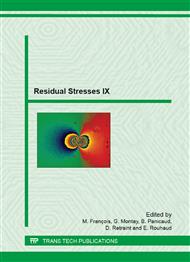p.141
p.147
p.155
p.162
p.169
p.175
p.181
p.187
p.192
Spatial Convolution of a Stress Field Analyzed by X-Ray Diffraction
Abstract:
X-ray stress analysis suffers from homogeneity limitations of the stress field in the analyzed volume. When this homogeneity is not fulfilled, it is possible to reduce the irradiated volume down to stress homogeneity achievement. New limitation however occurs : the diffracting sites become too few for stress homogenization. We show that the diffractometry analysis corresponds to a spatially convoluted stress field. The inverse convolution problem is posed. An example of regularization method is given.
Info:
Periodical:
Pages:
169-174
Citation:
Online since:
August 2014
Authors:
Permissions:
Share:
Citation:


